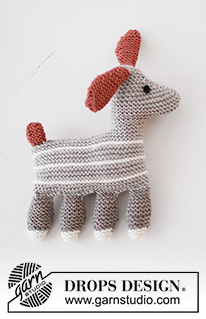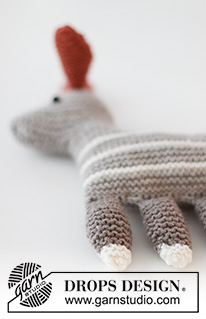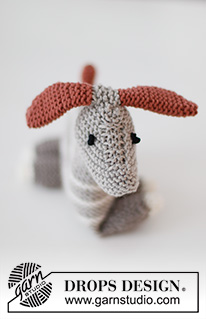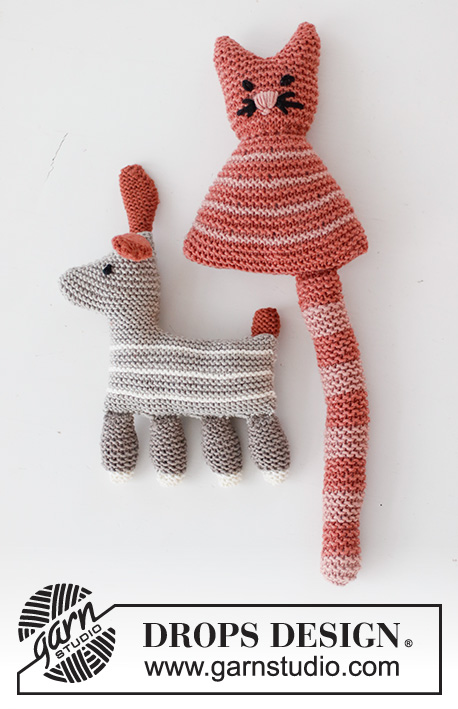Toby the Dog |
||||||||||||||||
 |
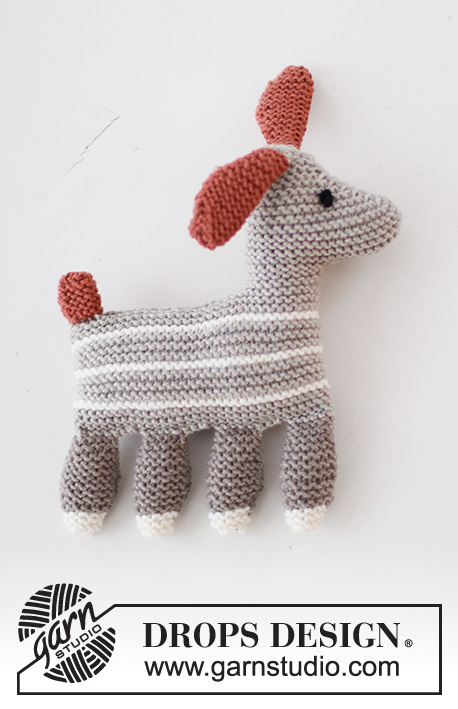 |
|||||||||||||||
Knitted dog for babies in DROPS Merino Extra Fine. Theme: Soft toys.
DROPS Baby 43-23 |
||||||||||||||||
|
------------------------------------------------------- EXPLANATIONS FOR THE PATTERN: ------------------------------------------------------- RIDGE/GARTER STITCH (worked back and forth): Knit all rows. 1 ridge = knit 2 rows. DIAGRAMS: Diagram A.1 shows how the piece is sewn together. Diagram A shows how to make French knots. ------------------------------------------------------- START THE PIECE HERE: ------------------------------------------------------- DOG – SHORT OVERVIEW OF THE PIECE: The piece is worked back and forth from the head towards the legs, on double pointed needles - change to circular needle when needed. The piece is filled with wadding and sewn together. The face is embroidered and the tail worked to finish. The whole piece is worked in GARTER STITCH – read description above. HEAD AND EARS: Cast on 18 stitches with one double pointed needle size 3 mm and DROPS Merino Extra Fine, colour light beige. Work 1 ridge. On the next row start the ear as follows: Knit 6, cast on 4 stitches. EAR 1: Turn. Work back and forth over the outermost 8 stitches – the other stitches are left on the needle – do not cut the light beige strand; it is used later. Change to colour cedar: Work 3 ridges over the 8 stitches. Then work as follows: ROW 1 (right side): Knit 1, 1 yarn over, knit until there is 1 stitch left, 1 yarn over, knit 1. ROW 2 (wrong side): Knit (yarn overs knitted twisted to avoid holes). Work 1 ridge. ROW 3 (right side): Knit. ROW 4 (wrong side): Knit. Work rows 1 – 4 two more times = 14 stitches. Work 4 ridges. ROW 5 (right side): Knit 1, knit 2 together, knit until there are 3 stitches left, knit 2 together and knit 1. ROW 6 (wrong side): Knit. Work rows 5 – 6 two more times = 8 stitches. The ear measures approx. 6½ cm, leave a strand-end of 20 cm and pull it through the 8 stitches. Fold the ear towards you. Use the light beige strand and cast on 4 new stitches on the needle with 2 light beige stitches. Work the next 6 stitches on the left needle (head), leaving 6 stitches on the left needle. Do not cut the strand, but change to colour cedar and cast on 4 new stitches on the right needle, then work 4 stitches on the left needle - 2 stitches remain on the left needle. Turn and work only over the 8 last stitches with colour cedar in the same way as the first ear. When the ear is finished, continue as follows: Fold the ear towards you. Use the strand in colour light beige and cast on 4 new stitches on the needle with 12 stitches in colour light beige (right needle). Then work the 2 last stitches on the left needle. There are 18 stitches in colour light beige for the head. HEAD: Work the nose as follows: ROW 1: Knit 8, 1 yarn over, knit 2, 1 yarn over, knit 8 = 20 stitches. Change to circular needle. ROW 2: Knit 8, knit the yarn over twisted to avoid a hole, make 1 yarn over, knit 2, 1 yarn over, knit the yarn over twisted, knit 8 = 22 stitches. ROW 3: Knit 9, knit the yarn over twisted, 1 yarn over, knit 2, 1 yarn over, knit the yarn over twisted, knit 9 = 24 stitches. ROWS 4-13: Work in the same way as row 3 (increase on each side of the middle 2 stitches) until there are 44 stitches. Continue with garter stitch until the head measures 6½ cm from the cast-on edge – measured along the side. NECK: ROW 1: Knit 11, cast off 22 stitches, knit 11 = 22 stitches on the needle. ROW 2: Knit 22. BODY: ROW 1: Knit 22 and cast on 22 stitches at the end of the row = 44 stitches. ROW 2: Knit 44 and cast on 22 stitches at the end of the row = 66 stitches. Work stripes as follows: * 3 ridges in colour light beige, 1 ridge in colour off white *, work from *-* two more times. Continue with garter stitch in colour light beige until the body measures approx. 7 cm from the 22 cast-on stitches on each side. Place the first 33 stitches on a double pointed needle size 3 mm. Fold the piece so the needles are on top of each other and the body is folded double. On the next row knit all the stitches from the front and back needles together 2 and 2 = 33 stitches. Now cast off for the legs as follows: Knit 6, cast off 3 stitches, knit 6, cast off 3 stitches, knit 6, cast off 3 stitches, knit 6. LEGS: The piece is now divided for 4 legs, with 6 stitches on each leg. Change to colour light brown and work each leg as follows: Cast on 6 stitches and knit the first 6 stitches from the body, turn. Work back and forth over these 12 stitches as follows: Work 3 ridges. INCREASE 1: Knit 1, 1 yarn over, knit 6, 1 yarn over, knit 5 = 14 stitches. Turn, knit (yarn overs knitted twisted to avoid holes). Work 4 ridges. DECREASE 1: Knit 1, knit 2 together, knit 5, knit 2 together, knit 4 = 12 stitches. Turn and knit back. Work 1 ridge. DECREASE 2: Change to colour off white. Knit 1, knit 2 together, knit 4, knit 2 together, knit 3 = 10 stitches. Turn and knit back. Work 2 ridges. The leg measures approx. 5½ cm, leave a strand-end of 20 cm. Pull it through the stitches and tighten. Work the other 3 legs in the same way. TAIL: Knit up from the right side 1 stitch in each of the outermost 5 stitches on one side of the body, then knit up 1 stitch in each of the outermost 5 stitches on the other side = 10 stitches. Work 6 ridges back and forth. Leave a strand-end of 20 cm. Pull it through the stitches, tighten and fasten the strand. Sew the tail together, in the outermost loop of the outermost ridge – see x in diagram A.1 and sew in the direction shown by the arrow. EYES: Embroider 1 eye on each side of the head. Use colour black and work a French knot - see diagram A and picture of the dog. ASSEMBLY: Sew the seam under the head/nose – see black star in diagram A.1 and sew in the direction shown by the arrow. Sew the cast-on edge together on top of the head - see white star in diagram A.1 and sew in the direction shown by the arrow. Fill with wadding as you go and continue to sew down the back of the head and along the back to the tail. Fold the ear double and use the strand-end to sew in the outermost loop of the outermost stitch, bottom up; the ear should not be filled with wadding. Sew the cast-on stitches at the beginning of the ear to the inside of the ear. Sew the body together from the tail to the legs - see square in diagram A.1 and sew in the direction shown by the arrow. Fold the leg double, use the strand-end and sew together in the outermost loop of the outermost ridge, bottom up - fill the leg with wadding as you go. Sew the cast-on stitches at the beginning of the leg to the first stitches on the leg. Repeat for the other legs. |
||||||||||||||||
Diagram explanations |
||||||||||||||||
|
||||||||||||||||

|
||||||||||||||||
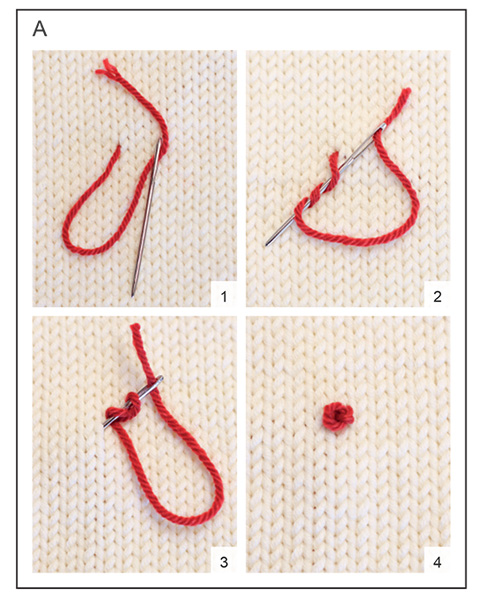
|
||||||||||||||||
|
Have you made this or any other of our designs? Tag your pictures in social media with #dropsdesign so we can see them! Do you need help with this pattern?You'll find tutorial videos, a Comments/Questions area and more by visiting the pattern on garnstudio.com. © 1982-2024 DROPS Design A/S. We reserve all rights. This document, including all its sub-sections, has copyrights. Read more about what you can do with our patterns at the bottom of each pattern on our site. |
||||||||||||||||











